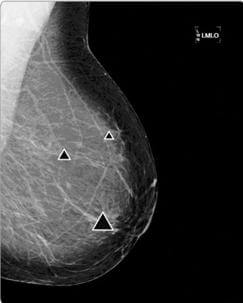If you want to find a utopia of humans and machines worker together in harmony, look no further than your nearest medical laboratory. A growing number of automated systems are allowing robots to assist lab technicians and doctors, making them much more productive. Some of the best examples come from women’s health. The FocalPoint GS Imaging System from Becton Dickinson (BD) scans through Pap tests and finds the ten most likely areas to contain abnormal cells that could indicate cervical cancer. Before a human ever has to sit down and study a slide, the FocalPoint has already done a large part of the work. Hologic’s R2 Image Checker performs a similar function, only it examines mammogram data. The MAX (also from BD) automatically performs tests and analysis on samples from pregnant mothers to detect deadly neonatal bacterial infections. Check out these technologies in the promotional videos below. Automated medical analysis augments doctors, allowing them to do more in less time. In the future that may mean robots replacing some medical specialists, but for now it’s heartening to know harmony between man and machine is literally saving lives.
Widespread adoption of Pap tests in the second half of the 20th Century helped bring about a 70% decline in cervical cancer deaths in the US. Improvements in testing and treatment have continued such that mortality for this disease is still falling as much as 3% a year. Pap tests have a clear positive impact and they are relatively cheap ($100 or less, typically). Yet Pap tests occasionally come under fire because we test so many woman so regularly and the costs add up. Estimates are that the US will spend tens of thousands of dollars per year of life saved. You don’t want woman to stop getting tested, so how do you offset the costs? By making the tests more effective and cheaper. BD’s Focal Point GS Imaging System allows a doctor to get through about twice as many samples each day. It increases effectiveness slightly (from ~79% to ~86%), and it allows humans to focus on just the areas that need their scrutiny. Watch how the FocalPoint automatically scans through Pap samples and detects abnormal cells in the video below:
(Stupid Flash video…please right click on the image and select “Play” to get the movie started)

The vast majority of Pap tests are normal. The same is true of mammograms. In both cases specialists may review hundreds of samples before coming to one that requires them to identify a very slight variation that needs to be examined further. Clearly this could lead to doctors missing important details. In mammography the solution has been “double readings” – essentially two people review each test. Hologic has another solution. The R2 Image Checker goes through mammogram images and finds regions of interest, indicating them on the image with a triangular mark. A single doctor working with computer aided detection (i.e. the R2 Image Checker) has been shown to be as effective as the double reading process. So, again, by adopting automated analysis a lab gets twice as much work out of every doctor. That’s a big incentive to change, especially when you consider how much more information is becoming available to radiologists. As you’ll see in the following video, Hologic is pioneering advanced forms of 3D imaging for mammograms. With technology like the R2 Image Checker, that flood of data can be better contained and managed.
Singularity Hub is a big fan of automation, and we’ve previously discussed how life science laboratories (including medical facilities) have been adopting robotic technologies for many years. Increasingly, however, those robots aren’t simply performing grunt work like mixing, heating, and sorting, they’re actually helping with the science as well. The BD MAX is used to detect Group B Streptococcus (GBS), which is the leading cause of newborn deaths in the US. About 5% of all infants that contract GBS will die, which is why it’s very important to screen mothers for the bacteria. As you’ll see in the following video, BD MAX does all the basic robotic things – moving samples, etc – but it also provides analysis that can assist the techs in quickly detecting GBS. Another step in the process gets automated and costs go down, efficiency goes up, and more lives are saved. Even robots that are just slightly smarter can make a big positive impact:
When it comes to automation, much of the discussion usually revolves around computers and robots replacing humans. We alternatively lament that jobs are lost and wonder at the skills of the new machines that seemingly operate without human intervention. Medicine, however, is a field where the paradigm is clearly not one of replacement, but one of augmentation. The FocalPoint, R2, and BD MAX give each technician/doctor the capability of doing twice as much in the same amount of time. They make medical specialists more effective. They allow us to focus on the key skills that make us human (pattern recognition, judgment, etc). In short, they make us better. As our global population continues to age (and expand) the medical field is seemingly guaranteed to keep growing for decades to come. In the near term, making human doctors better is only a positive thing. Yes, eventually we may have to worry (or rejoice) that specialties in medicine such as radiology or cytology are ripe to be automated almost completely. For now though, these technologies are simply saving women’s lives. And that is something worth celebrating.
So go and give a robot a hug…and a Pap sample. You can never be too careful.



